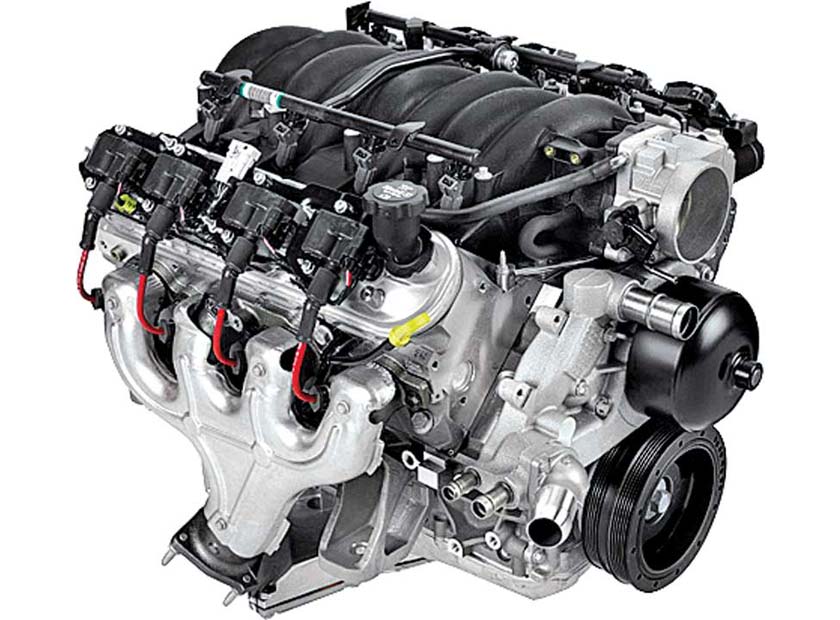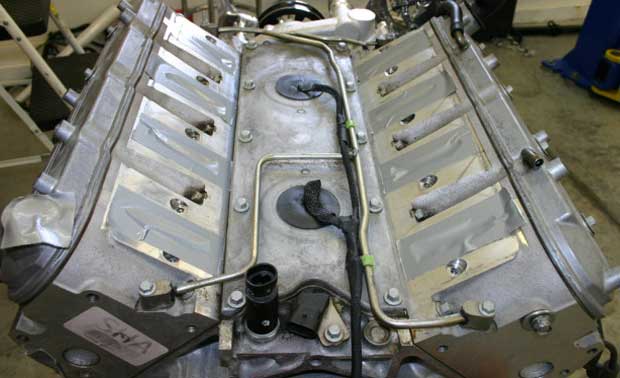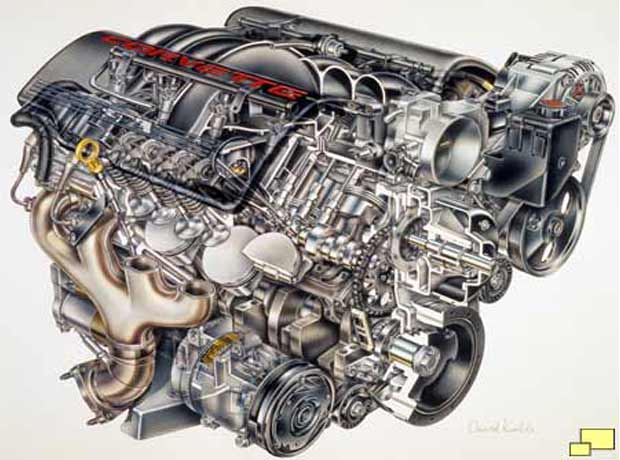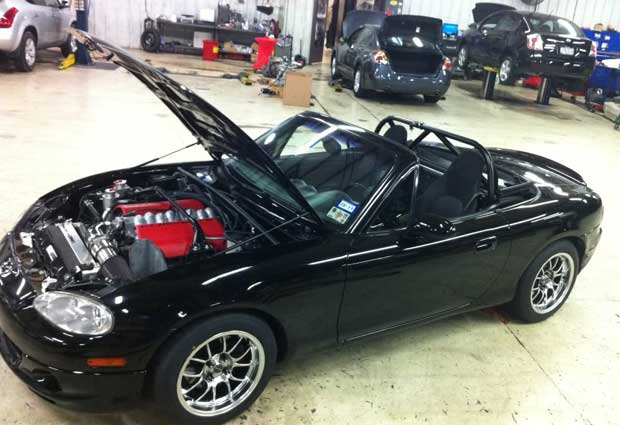Chevrolet LS Engine Family
Have you noticed that a lot of car enthusiasts are putting Chevy engines in their project cars? It almost seems like the Chevy LS is more preferred than building the factory engine.
There are a few good reasons why you should swap an LS engine into your project, especially if you’re looking for high performance and reliability.
Gen III
GM first introduced the LS engine in the 1997 Corvette. They called it the “Gen III small-block” now known as the LS1. The LS1 is a 5.7L engine, and it featured an all-aluminum design.
It also featured coil near plug ignition, and various other new engine management features. These new features made it vastly greater than the previous generation small block.
In 1998 the LS1 replaced the LT1 found in Camaros and Firebirds. Chevrolet then began producing an iron-block Gen III small block which came in the pick-up trucks and SUVs.
Gen IV
Chevrolet later produced the “Gen IV small-block,” which featured MPG-boosting cylinder deactivation. Gen IV also featured larger displacements compared to Gen III and re-engineered camshaft sensing.
These were all great improvements for the LS engine family, making it a word class engine. The Gen IV family includes the LS2, LS3, supercharged LS9, supercharged LSA, and the all-mighty LS7.
6. Engine Strength
What would a good engine be without a solid foundation? Chevrolet knew that the strength of the block was critical when they developed the LS engine. Let’s start with the block design.
Chevrolet designed the Gen III (LS) block as a “Y” block. The Y-block design helps increase rigidity in the main cap area. Previous small blocks didn’t have this design.
The Y-block design allows them to use six-bolt main caps on the crankshaft. Four bolts are facing vertically, and two bolts horizontally that clamp the block wall to the main cap.
This bolt-pattern is what GM engineers call snap-fit cross-bolting. This design provides excellent crankshaft and block rigidity.
RELATED: RB26 vs 2JZ: Which One is Better and Why?
Chevrolet took it a step further by not just designing an incredibly strong bottom end, but also a strong top end. Chevy designed the block to take extra long head bolts that thread deep into the block which minimizes cylinder bore distortion and variation in the head bolt torque spec.
The reduction in variation between head bolt torque spec can help with mass manufacturing of engines. Subaru and Toyota are currently facing these kinds of issues with the FA20.
RELATED: LS1 vs LS2: Which One is Actually Better?
Chevy also raised the camshaft farther away from the crank which allows them to clear a 4-inch stroke crankshaft. Chevy used a 4″ stroke crank to achieve the 7.0L displacement of the LS7.
To further increase the strength of the top of the engine block they used a valley plate. The valley plate is a large plate of metal that covers the valley where the lifters reside, increasing the strength of the block by bolting each side of itself onto one metal plate.
The pistons are the weakest point in the LS engine. They are pretty strong, but when you start getting into serious performance, they are the first to fail. All of this combined made the LS engine stronger and smaller than any other GM small-block before it.
There are people out there making close to 1,000 horsepower on stock bottom end LS engines.
5. Price
Chevrolet has produced the LS engine since 1997, and they came in everything rear wheel drive. Since used LS engines in so many of their cars and trucks, there is a slight overabundance of them which has kept prices fairly low.
You can walk into any junkyard in America and find an LS engine within a few minutes.
RELATED: Chevy LS vs Ford Modular: Which One is Better and Why?
Replacement parts are also very cheap. The main reason is that Chevrolet is one of the largest manufacturers in the US, and many companies make parts for Chevy products.
Although some parts can be expensive, parts are generally dirt cheap compared to high-performance Japanese engines.
A great example would be the world famous beater bomb, which is the true meaning of balling-on-a-budget. Beater bomb is a world famous street racing Fox Body Mustang.
He has blown up a few LS engines from spraying a ton of nitrous. Luckily all he has to do is walk into the junkyard with a few hundred dollars to get an LS engine.
4. Displacement Options
Since the LS engine came in a variety of automobiles, Chevrolet needed to develop different size engines for different uses. Chevy trucks came with iron-block 4.8L and 5.3L they also came with all-aluminum 6.0L and 6.2L engines.
Car engines came in 5.3L, 5.7L, 6.0L, 6.2L, and 7.0L size engines, and some configured for front-wheel-drive. There are also options when deciding if you want an iron or aluminum block.
The rise of stroker kits has also increased the number of displacement options. The LS7 can be pretty expensive, but you can always buy a stroker 427 ci kit for your LS3. Another popular stroker size is a 383ci LS1 stroker.
RELATED: 7 Reasons to Buy a Foxbody Mustang Today
If you count Chevy Performance’s LSX engines, then the biggest available LS engine would be the LSX 454 (7.4L). The cheapest of the LS engine family is the 5.3L truck engine since it came in most of the trucks and SUVs that Chevrolet has produced.
All of these engines have been pushed past 1000+ horsepower by racers, and have done so reliably.
3. Aftermarket
As you can imagine, the aftermarket for the Chevy LS has exploded since its massive rise. From just the basic bolt-ons like an intake/exhaust, all the way up the race-spec cylinder heads and turbo kits.
The most common modification being a high-performance camshaft, which is the best bang-for-buck upgrade you can do on the LS engine.
RELATED: 6 Things That Make the IROC Z28 the Ultimate Muscle Car
The rise in popularity of LS engines has also helped mold some of the world’s best engine builders into LS masters. Companies like Nelson Racing Engines have become extremely popular to do their knowledge of the LS engine.
These companies know how to get the best bang for buck performance out of them. From mild builds to high horsepower street cars, to full race cars, companies like NRE can build you one incredible little LS engine for your application.
Chevrolet Performance produces the LSX, the holy grail of Chevy engines, the most powerful being the LSX454r crate engine which produces a whopping 770 horsepower and 620 ft-lbs of torque.
Chevrolet Performance also produces high strength engine blocks, as well as many other components to hop up your LS engine. The aftermarket also makes a lot of swap kits, making it a breeze to swap a Chevy LS engine into basically any automobile you want.
2. Performance
Chevy knew what they were doing when they designed the LS engines. They designed an engine family that made good horsepower and good torque. How did they do this? The factory heads flow nearly as good as NASCAR heads did at the time (300+ cfm).
They achieved this by using modern computer technology to test different port lengths and designed to find the best performing head design. You may be surprised by how the port shape, size, and length can affect torque and horsepower ratings.
Chevrolet also designed the intake manifold using modern technology. They aimed for the LS engine to produce usable low-end torque and great top-end horsepower. They also focused on small features like the cam size.
They made the cam core massive, which means you can easily fit a .600+ lift cam and it won’t be that harsh on your motor.
RELATED: LS1 vs LS3: Which One is Better and Why?
All Chevy LS engines are known to respond to modifications very well, even an intake/exhaust will gain you substantial amounts of HP, the typical head/cam swap is known for gaining over 100 HP.
Some people even leave the stock heads on and have them worked over, combined with a big cam and many LS engines are making over 440rwhp with just head work and a cam.
What other engines can you name that produces that much horsepower with just a cam swap?
The internet sensation, “LSX Willys Jeep,” is a perfect example of the performance that can be achieved with an LS engine. Although this Jeep uses a pretty wild LS setup, it still proves a point.
1. Size/Weight
Would you believe me if I told you that a 5.7L LS1 would fit into a 1.6L Mazda Miata? The LS engine family is known for having smaller proportions than its competitor’s engines, making it much easier to swap into cars with small engine bays.
The Chevy LS platform is banned from some motorsports because it can be swapped into smaller cars and give them an unfair edge over the competition.
The main reason that they’re such a compact engine is that of their “old-school” pushrod design, as well as all of the modern designs they used when designing the engine block.
The push-rod design that they continue to use is unlike almost all modern engines which have overhead cams. You can achieve better performance and economy with an overhead cam but at the cost of a much larger and heavier engine.
RELATED: LS2 vs LS3: What’s The Difference?
Thanks to the all-aluminum design, a fully dressed LS1 is nearly as light as a cast iron four cylinders. For example, a stock 1995 Nissan 240sx with a full tank of fuel weighs in around 2917lbs, the same car under the same circumstances with an LS1 swap weighs in at 2950lbs.
That’s a gain of 32lbs, which is pretty much nothing considering you’d be gaining hundreds of lb-ft of torque, and hundreds of horsepower.
When it comes to engine vs. engine, the LS engine typically weighs less than a cast iron 4-cylinder, it’s not until both are fully dressed and filled with fluids that the LS engine becomes the heavier of the two.
I can’t even tell you how many times I’ve seen a four-cylinder vs. V8 debate going on and the opposing side always seems to say “heavy” while referring to V8’s, and specifically LS engines.
But little do they know that they weigh nearly the same amount as their little four bangers.
LS vs The World
Is the LS as good as I say it is? Well yes and no. Depending on how you look at it, the LS is the best street V8 available, but things like the Ford Modular are better race V8s. DOHC V8s such as the 1UZ, VH45DE, and Coyote are superior on paper and in design but don’t make as much power as cheaply as an LS.
There are superior V8s on the market, but, the low cost of the LS makes it the better option for most people. The LS will remain king as long as its prices stay low. You can read a lot more about this topic in our Chevy LS vs Ford Modular article.
Which LS Should You Swap in Your Car?
The world would be an awesome place if everyone could afford to put an LS9 in their car, but that’s not how it works. There are quite a few choices when it comes to which LS you should swap into your car.
If you have the money, an LS7 or LSA are awesome options. The LS7 produces a ridiculous amount of horsepower naturally aspirated. The LSA produces a ridiculous amount of power with its supercharger.
If you’re on a budget, then the truck LS-based engines are a great option. You can purchase an aluminum or cast iron 5.3L or 4.8L LS for a few hundred bucks. Install a cam and do a little head work and you’ll easily be making 400whp or more.
If you’re planning on boosting your project, the 4.8L truck engine will be perfect for you. The 4.8L can take insane amounts of boost completely stock and will perform well.
If you don’t want a barebone 5.3L or 4.8L you could always step up to a 6.2L truck block which is based on the LS3. With the larger displacement and slightly better cylinder heads, you can get your project in the neighborhood of 500whp or more.
LS1 vs LS2
As you probably know by now, the LS1 was the first of the LS family. It’s the engine that got the whole LS craze started. You would think the LS2 would be the next engine in line, but the LS2 didn’t come until 2005 and used a Gen IV design compared to the LS1’s Gen III design.
Even though there is an age and design gap, it’s common to see these engines compared to each other.
The most significant difference between these two engines is displacement: 5.7L and 6.0L respectively. The LS2’s intake manifold flows more air, as do the cylinder heads. The heads from the LS2 engine are identical to LS6 heads minus the sodium filled valves.
Compared to LS1 heads, LS2 heads flow more air, plus LS2 heads have smaller combustion chambers, resulting in a higher compression ratio. The LS2’s intake manifold has a larger opening and larger intake runners.
To put it simply, the LS2 has a lot of small updates compared to the LS1 that add up to a better overall engine. Unfortunately, the LS2 costs more second hand, consequently making LS1 being the more popular of the two when it comes to engine swaps.
Check out LS1 vs. LS2: Everything You Need to Know for more information on this topic.
LS1 vs LS3
One of the most popular LS engines is the LS3. Chevy introduced the LS3 in the 2008, and it was the most popular engine ever found in a base model Corvette. Like the LS2, the LS3 uses the Gen IV design.
The LS1 and LS3 have a lot on in common, but they also have a lot of differences.
The larger 6.2L of displacement helps the LS3 make significantly more power and torque compared to the LS1. The real difference that makes the LS3 so attractive are the cylinder heads.A
ll LS engines are known for their superb flowing heads. The LS1 flows 244cfm on the intake side of the head, an awe-inspiring feat for a production engine at the time. LS3 heads, however, flow an insane 293 cfm of air.
Unfortunately, LS3 heads will not fit on an LS1, as they require a 4” bore.
Another big difference between the two is the design of the intake ports. The LS1 uses a cathedral port design (as do LS2, LS6, and LQ truck heads) while the LS3 uses rectangular ports.
As tested by Hot Rod magazine, the LS3 intake is one of the best OEM intakes ever produced on any car. The heads are also some of the OEM heads ever produced. There’s no question that the LS3 is better than the LS1.
Read LS1 vs. LS3: Everything You Need to Know for more information.
Summary
Here’s the bottom line; the LS is cheap, light, compact, and makes a ton of horsepower. It can fit into nearly anything you want, and you can do it on a tight budget. From the average Joe to a professional racer, the LS engine is perfect for nearly anything.
There’s a lot of controversy about swapping an American engine into a Japanese car. Some call it blasphemy, and some call it genius. But with so much power, reliability, and such a large aftermarket backing, swapping an LS engine into your car makes sense.
Don’t take it from me though, check out some videos and see for yourself how fast LS swapped cars are.
Disclosure: As an Amazon Associate, I earn from qualifying purchases made through links on this website.








Thanks for the article. I’m a owner of a Chevy Truck, and it has a LS engine in it. I like the truck and the engine is just OK. I was scamed when I bought it but I know I can get it to look good. Engine and electrical??? But Your article gave me hope for the engine. Just have to figure out have it rebuilt or buy crate engine. And a new wireing harness. 1998 Silverado 4×4 (5.7)
Thank you for the great article. After I get used to owning a house I plan to build a car or two. I am already thinking 4.8 with cylinder deactivation with a pie in the sky goal of 40mpg.
Which manifold/EFI setup is used in the photo above? Those intake horns look,enticing. Thank you.
Only chevy motor was the gen 1 v8, from gen 2-gen 3 onwards was all gm, nothing chevy
its also quite a boring engine without a fair amount of mods
It’s the most used V8 other than the stock 5.0 when someone is building a 1/4 mile drag Fox body Mustang. You don’t see to many Ford engines in Chevy’s while on any day at the drags you will see several LS engined Mustangs! It might be boring but it leaves a bulge in your wallet even after turning it into a 900hp beast that runs and runs. The sound is not boring at all even when totally stock, but when built like mine in my S-10 it gives you goose bumps at idle all the way up to 8000rpm…..not boring.
I have a 2013 LS7, 427ci Z06 engine in my 1995 S-10 pickup that came from my totaled 2013 Z06 (girlfriend rear ended at light) which I also used the rest of the 6spm transaxle setup. It took a lot of engineering to make that work under the bed without showing to much of the transaxle from the side view, but when lowered down with the bags it looks incredible so it turned out perfect and with the near 50/50 weight distribution it handles better than my Z06 did.
I have very sticky Michelin Sport CupII 285/30ZR19 fronts, 345/25ZR20 rears which In front I removed the wheel well liner in the engine bay then moved them up 5″ did a lot of fabrication to make these wheels and tires tuck perfectly while able to get the truck perfectly level and as low as 2″ off the ground up to 8″ with a custom multi level airbag setup I fabricated, . For the massive rear tires I raised the inside of the bed bottom up until it was under the lip of the bed rail having also removed the wheel wells and replaced that area with flat steel pieces on each hole! The engine has no turbos or supercharger it’s 100% naturally aspirated and stepped on to the tune of 892hp @ 7925rpm/ 839lbft @ 3850rpm but above 600lbft from 1850rpm to 6600rpm. The truck weighs with a full tank (22 gallons) plus 185lb driver 3043lbs, with no driver or fuel around 2670lbs at my local recycler scales.
It’s hard to sneak up on anyone as a sleeper would because this LS7 has the meanest sounds of which you can hear it’s thumpidy thump at idle 2 blocks away.
GEN 1 and Gen 2s are inferior to the LS in any gen
Appreciate this article, I blew a head gasket in my 1985 z31 300zx and I was wanting to take advantage of the situation by LS swapping it from a chevy truck or something. This will help convince my dad this this will be a good idea to make my baby more reliable and give me better power to have some fun.
GM Ls-series engines using a Mercedes design M116/117 in 70s-80s..
Bullshit. Ford FE like lower block, Ford Y block style upper block, Chevrolet small block cylinder spacing, Ford small block head bolt and port arrangement, and a crankshaft driven oil pump. Nothing like a Mercedes pos.
2jz is the answere to the problem
What does the “LS” stand for in the name of the engine?
Thanks for the interesting lowdown. I use the factory block/rotating assembly LS1 in my Aussie made ’04 Pontiac GTO; I had the #421 heads cut to bump up the compression, had the stock intake cut to fit & port matched, run an aggressive sounding CompCams Thumpr tripping their lifters/rods/beehive springs, and push all the remains out of the odd factory exhaust (’04’s were different, blocked crossover and a turbo muff on one side, chambered muff on the other, both sides exit on the driver’s side). I like the sound, and it doesn’t attract more attention (the car’s already TorRed) less’n I back out over 2000rpm.
This was done at a 116,xxx mile teardown & inspection; the bottom end was fine, got new seals/gaskets. I do experience the famous LS1 piston slap at startup; I let the Mobil 1 warm prior to pedalling, and use Lucas Oil’s synthetic additive.
Additional mods are DUI coil packs & 8mm plugwires, a Jet Engineering computer repro, their pigtail to eliminate the hated 1st to 4th forced shift, an Australian repop of the B&M Ripshifter for my Tremec 6spd, a McLeod lightweight flywheel and a Centerforce dual disc clutch.
I turned 120,000 yesterday (14 Sep 19), and am as happy with the 5.7 LS1 today as I was when I wrote the first check. Spins up faster than any early small block, makes 396 power with less than 283 weight, can be digitally adjusted with a laptop without greasy hands, can top 15mpg city/25mpg hwy with *ahem* discretion, and according to the computer achieves 8.2mpg at a real 140mph (police calibrated speedo & GPS).
Next stage is a bored/stroked LS shortblock with 408cid, and a custom made 6.6 insignia replacing the factory 5.7 on the rear deck.
As is, this quite heavy car will always pull high 12.90’s/low 13.10’s on the Goodyear streets- I won’t run slicks due to the complications of the fully independent rear axle/suspension, and the (gasp!) cost of replacement parts. It’s not a racecar anyway.
Conclusion? I grew up in the ’60’s in a GM family (dad worked at the Delco-Remy plant in Anderson IN his entire life, and died of a heart attack at 53 while at work); I was licensed to drive in ’74. All the Detroit craziness of the ’60’s & early ’70’s was basically worthless then, due to the “Oil Embargo”… save for teens living at home, such as myself.
I’ve driven and had, but the LS impresses more than any RB block Mopar, FE Ford, or any first gen Mark IV Chevy Rat motor, through design, power v. weight, modification ability, and simple user friendliness.
Um, and to get an aluminum block for a RB, FE, or traditional Mk IV Chevy big block? You gots Jay Leno bucks. Or your own foundry.
I’ll always be a GTO guy, but I love ’em all, and wish that it could go on forever. But we’ll be electric soon- fast & quick? Oh Hell Yeah. Sound good? Not so much. Sigh.